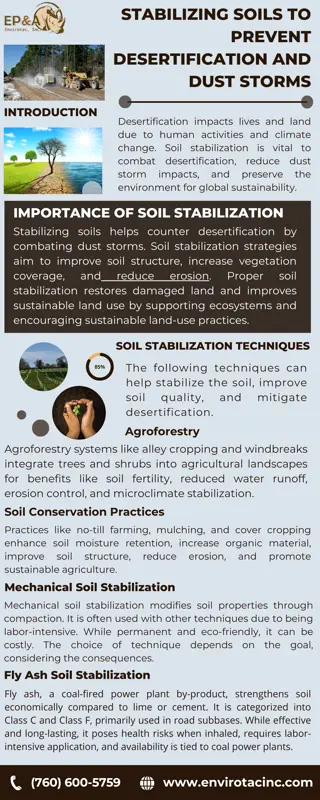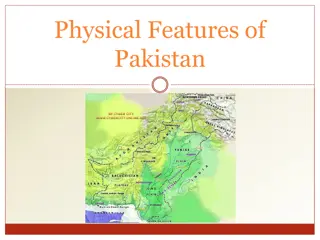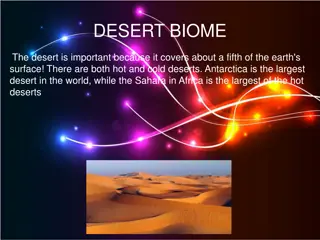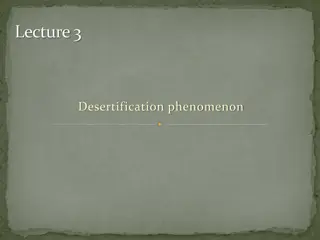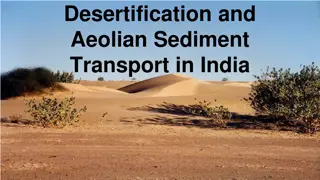Understanding Deserts and Desertification: Factors and Consequences
Delve into the intricate mechanisms behind the formation of deserts and desertification. Explore how low and high-pressure zones, monsoons, and global air pressure contribute to the creation of arid landscapes. Discover the impact of air currents, humidity, and the Equator on the development of deserts worldwide.
Download Presentation

Please find below an Image/Link to download the presentation.
The content on the website is provided AS IS for your information and personal use only. It may not be sold, licensed, or shared on other websites without obtaining consent from the author. Download presentation by click this link. If you encounter any issues during the download, it is possible that the publisher has removed the file from their server.
E N D
Presentation Transcript
Deserts and Desertification lecture 2 collected by : Maher M Alasadi
Definitions Low Pressure Zone: Density of air < average. Warm, wet air that moves up reduces atmospheric pressure. The heart of the low-latitude dry climates lies in the vicinities of the Tropics of Cancer and Capricorn. As the warm, wet air rises, its ability to hold water is reduced and precipitation results. Low pressure = precipitation likely. High Pressure Zone: density of air is > average. Air is sinking, increasing atmospheric pressure. Cool, dry air so precipitation is unlikely clear and sunny conditions. Winds: pressure-driven currents of air moving from high pressure to low pressure. Can identify wind direction on an isotherm map. Isobars: lines of equal/constant pressure.
Monsoons Continents warm quickly in the summer and cool quickly in the winter. Oceans are slower to heat up and cool down and this affects air currents so this system sees its winds change direction with the seasons Dry regions cover 30% of the Earth s surface The dry regions of the world encompass about 42 million km2 , a surprising 30 percent of Earth s land surface. No other climate group covers so large a land area
What causes deserts? Important factors: 1-Global distribution of air pressure wind Relationship between rainfall evaporation www.weatherchannel.com www.weatherchannel.com
Why do deserts form ? (2) DESERT At the Equator (A) hot air rises and lifts lots of moisture into the air where it makes clouds and rains. JUNGLE At (D) the air falls back to earth but it s now DRY air, and as it falls it WARMS UP so no clouds form EQUATOR D A
30*North, falling dry air means no clouds form and you get DESERT At the Equator rising air causes lots of clouds and rain 30*South, falling dry air means no clouds form and you get DESERT
For this reason, vast tropical rainforests grow near the equator. Driven by wind 2- Solar energy produces differential heating 3- Coriolis effect(: Apparent force that moving objects experience due to the planet s rotation, tending toward the right in the northern hemisphere and to the left in the southern hemisphere ).
NOTE: high pressure around 30 N and 30 S, as well as at the poles, = DESERTS.
4-Effect of tilt and seasons and continents
The part of the earth that receives most of the suns heat is the tropics the region about the equator that lies between the tropics of Cancer and Capricorn. In the tropics the sun s rays hit the earth almost at right angles, concentrating their heat energy on the smallest surface area. They also pass through the least depth of atmosphere, with minimal scattering and spreading, before they reach the surface. Farther north and south from the equator the sun s rays approach the earth at a slanting angle and their heat energy covers a correspondingly larger area 5-GLOBAL OCEAN CURRENTS The planetary wind system plays an important role in the creation of the oceans surface currents. In general, these currents follow the enormous circulation loops around the oceans, delivering a huge supply of heat from the equator to high latitudes. Most of the currents heat is lost along the western boundaries of oceans, so that time they make their return journey along the eastern boundaries they are cold.
The air now moves on, over the peaks of the mountains and down the leeward slopes those lying away from the prevailing winds. By now it has lost most of its moisture content, so that little or no rain falls, creating a dry region on the leeward side of the mountains
B- great distance from the ocean: since most rainfall comes from water evaporated from the sea, a great distance from the ocean is another factor that can create deserts, The air gradually loses its moisture and moves on




